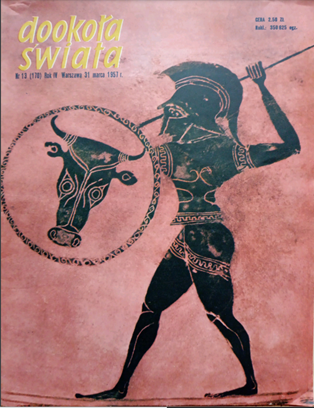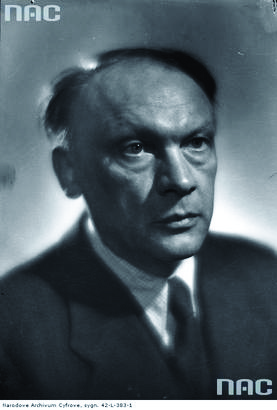Title of the work
Country of the First Edition
Country/countries of popularity
Original Language
First Edition Date
First Edition Details
Jan Parandowski, „Z antycznego świata. Grecja. Wielkość kultury greckiej”, Dookoła świata 13 (1957): 8–9.
Genre
Article in a periodical*
Essays
Target Audience
Crossover (schoolchildren, teenagers, young adults)
Cover

Cover with kind permission of the copyright holder for the magazine Dookoła Świata (1954–1976).
Author of the Entry:
Marta Pszczolińska, University of Warsaw, m.pszczolinska@al.uw.edu.pl
Peer-reviewer of the Entry:
Elżbieta Olechowska, University of Warsaw, elzbieta.olechowska@gmail.com
Katarzyna Marciniak, University of Warsaw kamar@al.uw.edu.pl

Photograph by Edward Hartwig, retrieved from the National Digital Archives.
Jan Parandowski
, 1895 - 1978
(Author)
Classical philologist and archaeologist. An outstanding and prolific author of books related to Antiquity; translator of classical masterpieces. Contributed to many Polish newspapers and magazines. Chairman of the Polish PEN Club from 1933 to 1978. Recipient of prizes for outstanding literary achievements, such as a bronze medal received at the 1936 Berlin Summer Olympics for his book Dysk olimpijski [Olympic Discus]. Member of the European Society of Culture. In 1962 he was elected Vice-President of the International PEN. An exceptionally successful supporter and advocate of Classical Antiquity in Poland. His Mitologia. Wierzenia i podania Greków i Rzymian [Mythology. Beliefs and Legends of the Greeks and Romans], still often read even in primary school, remains for many generations of Polish readers a fundamental source of the knowledge of ancient myths.
Major works: Eros na Olimpie [Eros on the Olympus], 1924, Mitologia. Wierzenia i podania Greków i Rzymian [Mythology. Beliefs and Legends of the Greeks and Romans], 1924; Wojna trojańska [Trojan War], 1927; Oscar Wilde’s biography Król życia [A King of Life], 1930; Dysk olimpijski [Olympic Discus], 1933; Niebo w płomieniach [Heaven in Flames], 1936; Trzy znaki zodiaku [Three Signs of the Zodiac], 1938; Godzina śródziemnomorska [The Mediterranean Hour], 1949; a study on creative writing Alchemia słowa [Alchemy of the Word], 1951. He also translated into Polish Caesar’s Civil War, 1951, and Homer’s Odyssey, 1953.
Sources:
Krełowska, Danuta, Jan Parandowski: życie i twórczość, Toruń: Wojewódzka Biblioteka Publiczna i Książnica Miejska im. M. Kopernika, 1989.
Paciorkowska, Monika, Jan Parandowski, slideshare.net (accessed: December 30, 2020).
"Parandowski Jan", in Jadwiga Czachowska and Alicja Szałagan, eds., Współcześni polscy pisarze i badacze literatury. Słownik biobibliograficzny, vol. 6: N–P, Warszawa: Wydawnictwa Szkolne i Pedagogiczne, 1999, 254–260.
"Parandowski, Jan", in Encyklopedia PWN, encyklopedia.pwn.pl (accessed: December 30, 2020).
wikipedia.org (accessed: December 30, 2020).
Życiorys Jana Parandowskiego, kul.pl (accessed: December 30, 2020).
Bio prepared by Joanna Grzeszczuk, University of Warsaw, joannagrzeszczuk1@gmail.com
Summary
The weekly Dookoła świata [Around the World] (1954–1976) was intended to be a travel magazine and “a window to the external world” for Polish teens in the Polish People’s Republic. It published reports from anywhere in the world and novels in installments (in this issue by H. Balzac), novellas and/or short stories, interviews, articles about art, essays, fun facts, and many more materials, attractive to the young reader.
The text by Parandowski, which inspired the cover of this particular issue, is not a story or myth retold but rather a short popular text – a reflection on how the culture of ancient Greece influenced contemporary reality in the 1950s. First, Parandowski mentions archaeological discoveries and decipherment of the Linear B script, which helped to learn more about Greece before Homer. Next, he briefly presents Greek literature, especially theatre, focusing on its lasting impact (even if we are often unaware of it). He also mentions other genres originating in Ancient Greece, such as philosophical dialogue or romance. Then the author presents the development of Greek geometry, discusses the most important scholars and their achievements, and lists other disciplines: medicine, linguistics, philology, history, archaeology, ethnography, and cultural studies. The last field of Greek brilliance Parandowski brings up is art, the foundation of western cannons of beauty and harmony; as it was copied and reshaped in many ways, it remains relevant today. Finally, the article concludes that people incapable of equalling the Greek genius could never take the Greeks’ place in history. It ends with a description of how Greek thought was passed through many centuries to our times, even though Greece was conquered.
Analysis
In 1957 the total population of Poland was 28 535 000*. There were 4 836 100 young people aged 14–24. Dookoła świata was intended for this demographic and over 350 000 copies were printed, which was a significant volume. Each copy had multiple readers as it was shared among family members, friends, and neighbours. Thus the real reach was, in fact, more extensive. The magazine was so popular because young people, unable to travel abroad and see other countries, peoples, and cultures for political and economic reasons, were interested in what the world beyond the “Iron Curtain” looked like. Although the magazine’s content was usually connected to travel and discovery of the world in a geographical dimension, the editors of the issue decided to publish a text describing Ancient Greek culture written by Jan Parandowski, one of the most famous and popular Polish authors who ever wrote about Antiquity. They knew the importance of classics as a necessary part of Polish education and any education worth its name.
The presence of the text among the other contents of the issue may also point to an increased need to present Greek Antiquity to young readers: young people attending clandestine classes during WW2 could not study Latin and Greek to the same extent as their peers before the war. There was an urgent need to compensate for the shortcomings caused by the war. Parandowski strives to fill this gap with his text, explicitly presenting, in a nutshell, the most eminent Greek achievements in many fields of science, literature, art, and culture. He presents the topic and his reflections with passion and evident enthusiasm for ancient Greece, its thought and spirit. His language is plain and elegant but not free from praise and rhetorical exclamations of awe, as if Parandowski, a great admirer of the Greek culture, wanted the reader to share his approach and keen interest in Antiquity.
The title used for the issue about Antiquity inspired Parandowski to write Z antycznego świata – a book with a collection of elaborate essays and a similar focus on ancient history and culture.
* According to the statistical yearbook for 1958, Rocznik statystyczny 1958, Warszawa: Główny Urząd Statystyczny PRL, 1958, 19 (accessed: December 8, 2022).
Further Reading
Selected bibliography concerning Jan Parandowski’s work and life see here.
Frycie, Stanisław, “Czasopisma dla dzieci i młodzieży okresu powojennego (1945–1970)”, Kwartalnik Historii Prasy Polskiej 3 (1977), 49–73.
Harjan, George, “Jan Parandowski: A Contemporary Polish Humanist”, Books Abroad 34. 3 (1960): 223–226.
Waksmund, Ryszard, “Periodyki dziecięce w systemie prasy. Propozycje metodologiczne do badań nad czasopiśmiennictwem dla dzieci i młodzieży”, Litteraria vol. 14 (1982), 149–163.


